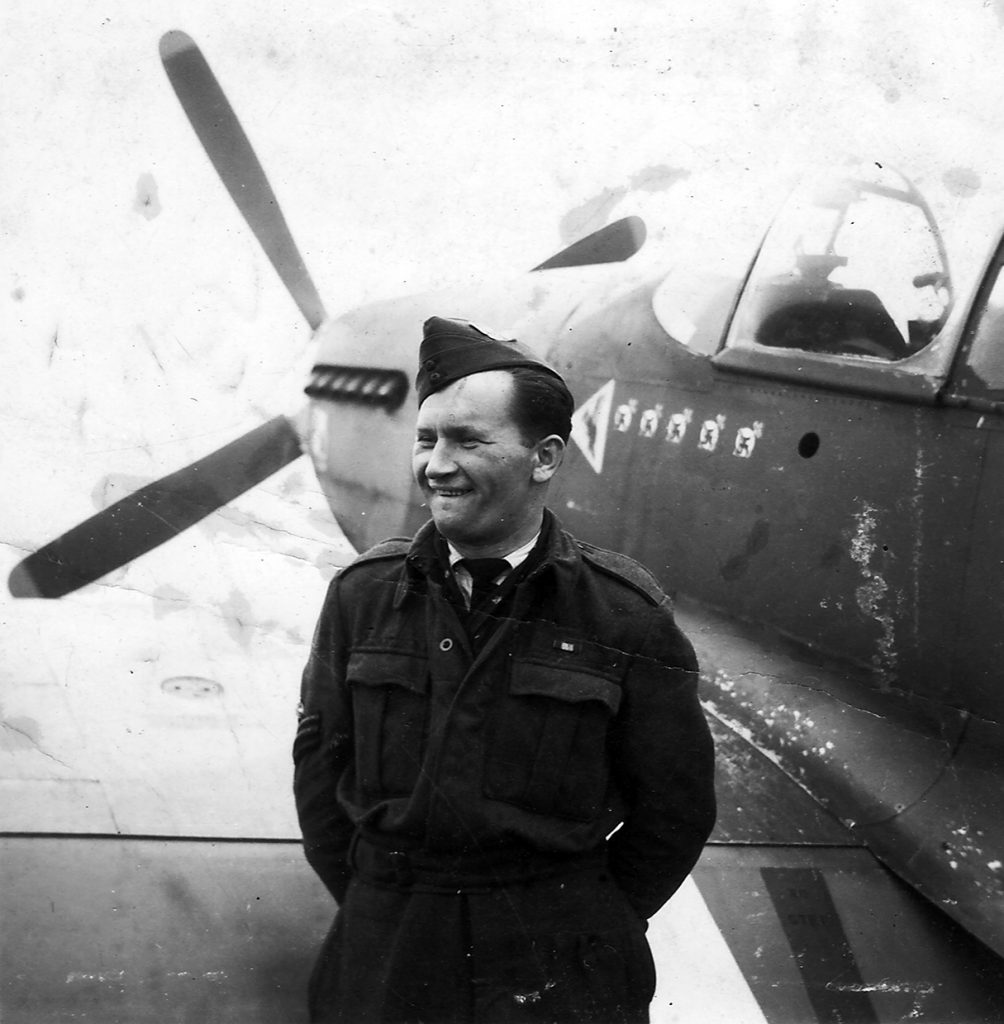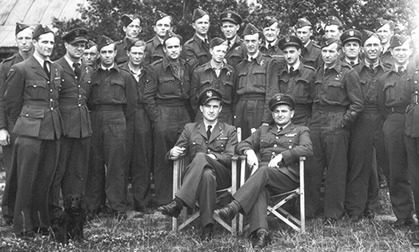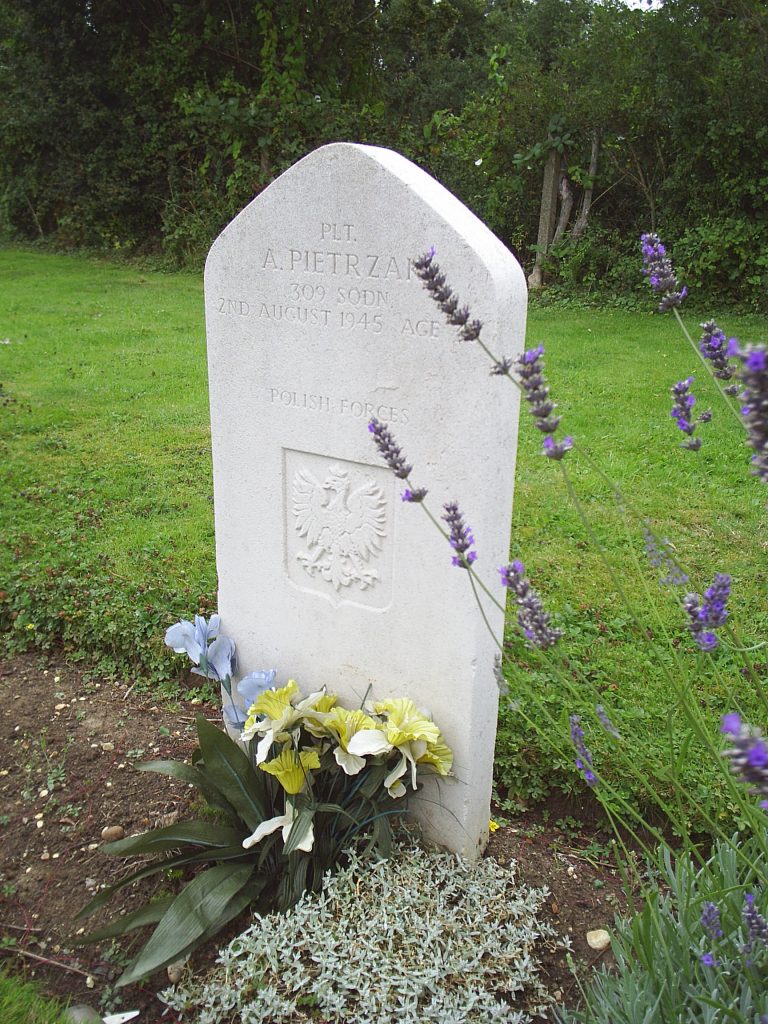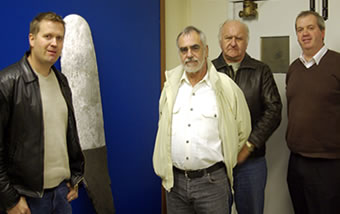
Pilot: Warrant Officer Aleksander Pietrzak (P783147) – Tragically Killed
Squadron: No. 309(P) Polish Squadron
Operation: Squadron formation exercise & dive bombing practice
Date of loss: 2nd August 1945
Time of incident: 11.15 a.m.
Aircraft Type: North American Mustang III
Aircraft Serial No: FX876

Mustang III 309 Polish Squadron
This is the brief story of a Polish fighter pilot who served with the Royal Air Force.
In January 1943, Sgt Pietrzak was flying Spitfires at 58 O.T.U. (Operational Training Unit). He transferred to No. 316(P) Polish Squadron and flew on operations from February 1943 until March 1944, and took part in defensive operations against the German V1 flying bombs. He joined No. 309(P) Squadron in February 1945.
Aleksander Pietrzak’s total flying time as pilot by day was 784 hours, of which 246 hours were in Mustang fighters. He became senior N.C.O. pilot of the Squadron, and was highly thought of by his Squadron Commander.
He had distinguished himself beyond the call of duty in the defence of Great Britain during the V1 rocket attacks of 1944.
He survived the air battles of World War II only to tragically lose his life in a flying accident on the 2nd August 1945.
No. 316(P) Polish Squadron and the “Flying Bombs”
Between June 13th 1944 and March 29th 1945, a total of 9,251 V1 flying bombs (known as Doodlebugs or Divers) were plotted by the Royal Observer Corps (ROC) from the 1,500 Observer Posts. Of these 2,419 reached London. The total number destroyed was 4,261 – 1,971 by anti-aircraft fire, 1,979 by the skilled flying of the pilots of the Royal Air Force, 278 by balloons and 33 by the Royal Navy. A total of 412 came down in the county of Essex. Sgt Aleksander Pietrzak of No. 316(P) Squadron was personally responsible for destroying 5 divers!
On the 12th July 1944 Sgt Pietrzak was detailed to carry out diver patrols against the incoming tide of V1 flying bombs. Flying Mustang III serial number FB378 Sgt Pietrzak intercepted a Diver and pressed home his attack! After several bursts of fire from his four 0.5 calibre machine guns, the Diver suddenly exploded sending hot twisted debris through the air, some of which smashed into his aircraft causing serious damage to the flying controls. Sgt Pietrzak had no option but to abandon the stricken machine after control was lost.
Whilst serving with No. 316 Squadron Aleksander Pietrzak carried out fighter escort duties protecting Allied bomber sorties to Germany. On two occasions Sgt Pietrzak was involved in combat with defending Messerschmitt Bf 109 fighters, the first victory was on the 14th October 1944 and the second four days later on the 18th where he claimed one destroyed and one shared. His last combat was on the 23rd March 1945 on this occasion he claimed a Messerschmitt Me 262 jet fighter as damaged. Shortly after, Aleksander Pietrzak, now promoted to Warrant Officer, was transferred to No. 309 Polish Squadron stationed at Andrews Field (Great Saling) Essex.

Old and new CO sitting in front of the group of No.309 Squadron pilots: S/Ldr Glowacki (right) and S/Ldr Pietrzak. Standing are: (from left) Sgt Halka, F/Lt Klawe, F/Lt Haczkiewicz, Sgt Kogut, P/O Czerni, Sgt Loska, Sgt Eisenbach, F/Sgt Godlewski, Sgt Zaufal, F/O Stankiewicz, W/O Murkowski, P/O Turek, ?, ?, ?. First from in the back is F/O Wisniewski, between Stankiewicz and Murkowski is F/Lt Birtus.
1st August 1945
P-51 Mustang III with the serial No. FX 876 moved to the workshop to undergo routine minor inspection. The airframe was built by North American Aviation Inc., and its total flying time was 307 hours. All modifications affecting airworthiness except No.691 had been embodied. The engine was built by the Packard Motor Car Company, No. V 324217 and its total running time was 664 hours. Both airframe and engine had been properly maintained and serviced and both had been certified fit for flight at 0845 hours on August 2nd.
2nd August 1945
At 10.15 hours, Mustang FX 876 took off on its first flight since the inspection was completed. It should be noted that the aircraft was not test flown. The pilot, W/O Pietrzak, had been briefed to take part in a Squadron formation exercise which was to be followed by dive bombing practice. FX876 was one of the first pair in the formation to leave the ground. The other member of this pair was the Squadron Commander. Almost as soon as the two aircraft were airborne, W/O Pietrzak overtook his leader and a few seconds later called him on the R/T (radio transmitter) to state that his rudder control had jammed and that he could not use starboard rudder but he could still apply port rudder. The Squadron Commander immediately ordered him to return and land and W/O Pietrzak thereupon turned away and disappeared. Some four minutes later, after the rest of the Squadron had formed up with the leader and W/O Pietrzak’s original place in the formation had been filled, FX876 reappeared and W/O Pietrzak requested permission to rejoin, stating that his aircraft was now serviceable. This permission was granted. Various squadron formation manoeuvres were then carried out for a period of forty minutes, during which FX876 appeared to fly normally.
Dive bombing practice then began from a height of about 12,000 feet.
The Squadron formed line astern with W/O Pietrzak as number 7. Each aircraft in turn pulled up into a stalled turn to the left and entered its dive, the instructions to each pilot being that recovery should be affected at 5,000 ft. FX876 entered its dive in exactly the same way as had those aircraft ahead of it, but, instead of pulling out at 5,000 ft, its dive was seen by the pilot of number 8 aircraft which was close behind, to become suddenly steeper until it reached an angle over the vertical. Number 8 realised that something was amiss and endeavoured to follow FX876 in order to keep it under observation.
The pilot of number 8 stated that when FX876 started to dive over the vertical he also noticed that it was side-slipping to the left and he declared that he had great difficulty in following it. He stated that he then saw it carry out an aileron turn one and a half times round and the pulled out of its dive inverted at an altitude well under 100 feet.
The pilot of number 8 lost sight of it at this point because his own airspeed was over 500 m.p.h. I.A.S. and his height was only around 3,000 ft. He therefore had his attention fully occupied in recovering normal flight, which he did by using his tail trim after unsuccessfully trying to ease back the stick.
He then caught sight of FX876 again. It was still inverted and climbing.
Although he himself was still travelling at very high speed, FX876 overtook him and nosed over into a dive which continued to the ground.
It subsequently transpired that W/O Pietrzak had fallen out of his aircraft whilst it was inverted and travelling at tremendous speed across Andrews Field Aerodrome at a height of only about 20 ft. His body was found near by. He had undoubtedly been thrown from the cockpit under high negative “g”. The fact that no pieces of the cockpit hood were found way from the main wreckage suggested that the hood was open when the pilot was ejected. W/O Pietrzak was killed instantly.
The funeral of Aleksander Pietrzak was held at 3.00 p.m on the 7th August at Epping Cemetery.

We are now in touch with Kelvin Youngs whose mother was married to Pietrzak. Kelvin has a half brother Stefan, who was Aleksander’s son. Stefan lives in the USA.
I am Aleksander Pietrzak’s son. I was just 3 months old and my mother just 17 when my father and her husband died. It was so strange to hear you and your compatriots had recovered parts of the wreckage from the crash that changed our lives forever. I never imagined anything would be left.
I have made many lonely trips out to Epping to visit his grave and those of the other Poles buried nearby. I felt very moved to see your photo by his grave: it always upset me to think he lay there unremembered by the world passing him by.
My father’s only brother Ryszard, who fought throughout the war in the Polish Secret Army (AK or Armia Krajowa), came to visit his brother’s grave in 1982 or thereqbouts with me and was of course very moved. His comment was to the effect, if my brother had to die, what finer place could he rest than here in this peaceful English churchyard. He brought some earth from his mother and father’s grave in Warszawa with him and we buried it at the headstone in Epping, and he took some English earth from the grave back to bury it at his parents’ grave, where he too now lies.
My father was the recipient of the Virtuti Militari, the highest award for gallantry in the face of the enemy granted by the Polish nation.
In May this year I took my father’s medals and his logbooks to the Polish Air Museum in Krakow where I presented them so that a part of him at least could be back in the Poland he loved and so that his memory could be honoured there for generations to come. The Poles have long memories and are a proud nation, and none are more highly honoured than the Polish airman who fought so tenaciously in the RAF for freedom.
We have some (but too few) photographs and would be honoured to share them with you. My brother Kelvin is undertaking research and has assembled quite a lot of material which he will share. I am also friends with 2 eminent Polish war historians and authors, Robert Gretzyngier and Wojtek Matusiak. Kelvin will show you the book they wrote (published by Osprey) a few years ago called Polish Aces of World War 2. I will keep them up to date with your efforts to honour my father and all those from Poland who fought so long and so hard by the side of their British and American comrades in arms. The Poles of course, were in the war opposing the Germans longer than anyone else, from the very first to the last day.
Respectfully Yours
Stefan Pietrzak

On Monday 17th December 2007 the family including the son of Aleksander Pietrzak (from the USA) visited the display which is being erected in honour of Aleksander the pilot of Mustang FX876. The family also presented the museum with a Polish Flag which will now be incorporated into the display. Also an very rare photo of Mustang FX876 in flight was which was located while on a visit to Poland by Kelvin Youngs and a copy of which was presented to the museum to include in the display. The Wings Museum would like to thank both Kelvin Youngs and Stefan Pietrzak for the kind words, they will always be welcome at the Wings Museum.